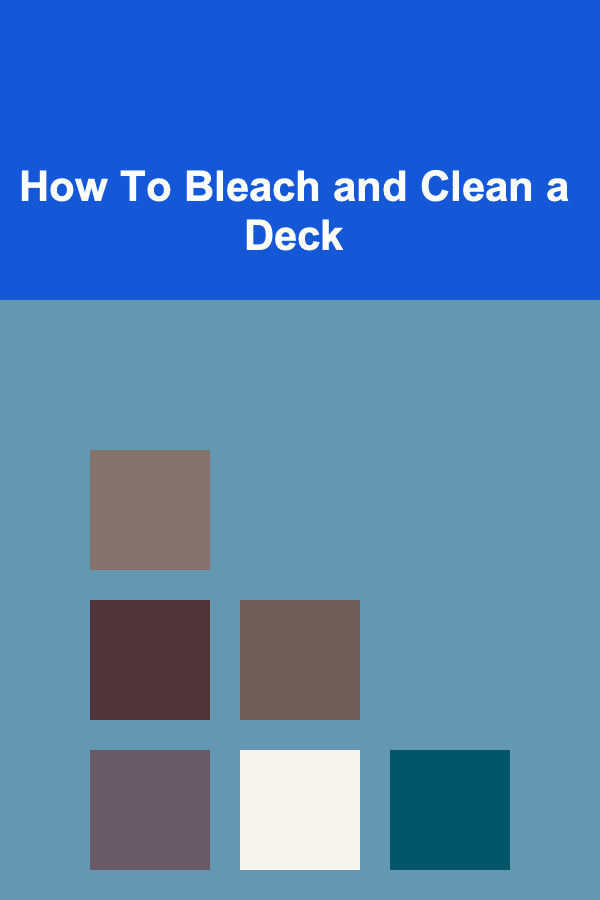
How To Bleach and Clean a Deck
ebook include PDF & Audio bundle (Micro Guide)
$12.99$5.99
Limited Time Offer! Order within the next:

A deck is a beautiful addition to any home, offering an outdoor space for relaxation, entertainment, and enjoying nature. However, the wear and tear of time, exposure to the elements, and the accumulation of dirt, mildew, and algae can leave your deck looking dull, dirty, and worn out. Regular cleaning and maintenance are key to ensuring your deck remains a welcoming and attractive feature of your home. One of the most effective ways to restore your deck's original beauty is by using bleach to clean it.
In this article, we will delve into the steps required to bleach and clean a deck, the benefits and potential risks of using bleach, and some alternative cleaning methods. We will guide you through the process of cleaning your deck in a safe and efficient way, ensuring a fresh, beautiful, and long-lasting outdoor space.
Why You Should Clean and Bleach Your Deck
Before diving into the cleaning process, it's important to understand why regular cleaning, particularly with bleach, is essential.
1. Remove Mold, Mildew, and Algae
Mold, mildew, and algae thrive in moist environments, especially in areas with high humidity or frequent rainfall. These microorganisms can cause discoloration and deterioration of the wood, leading to a slippery surface, which can pose a safety risk. Bleaching your deck is an effective way to kill and remove these harmful growths, restoring the deck to its original state.
2. Revitalize the Deck's Appearance
Over time, dirt, grime, and stains from food, beverages, or even fallen leaves can make your deck look unattractive. Bleaching helps to lighten dark stains, remove buildup, and bring out the natural color of the wood, leaving it looking fresh and rejuvenated.
3. Extend the Life of Your Deck
By keeping your deck clean and well-maintained, you help preserve the integrity of the wood. Bleaching removes harmful substances that could cause rot, discoloration, or damage, helping to extend the life of your deck.
4. Increase Property Value
A well-maintained deck can add curb appeal and increase the value of your property. A clean, bright, and structurally sound deck is more inviting and desirable to potential buyers.
Safety Considerations Before Cleaning Your Deck
While bleaching a deck can provide excellent results, it's important to be cautious and follow proper safety protocols to avoid harm to yourself, others, and the environment. Here are some important safety tips:
1. Wear Protective Gear
Bleach is a powerful chemical, and you should take precautions to protect your skin, eyes, and lungs. Wear long sleeves, gloves, and protective goggles to shield yourself from splashes. Additionally, wear a mask to avoid inhaling bleach fumes.
2. Ensure Proper Ventilation
If you're cleaning your deck in an enclosed space, make sure that the area is well-ventilated. Open doors and windows, or use fans to improve airflow and disperse fumes.
3. Test the Bleach Solution on a Small Area
Before applying bleach to the entire deck, it's advisable to test it on a small, inconspicuous area. This will allow you to check for any potential damage to the wood and determine whether the solution will achieve the desired results.
4. Protect Plants and Furniture
Bleach can damage surrounding plants, flowers, or lawn areas, so be sure to cover any plants with plastic or tarps. Also, move outdoor furniture off the deck to prevent it from coming into contact with the bleach solution.
Materials You Will Need
Before starting the cleaning process, make sure you have all the necessary materials and tools. Here's a comprehensive list of what you'll need:
- Deck cleaner: A deck cleaner or wood cleaner will help to remove surface dirt and grime before using bleach.
- Bleach: Standard household bleach (sodium hypochlorite) is commonly used, but oxygen bleach or specialized deck bleach is also an option.
- Water: For diluting bleach and cleaning the deck.
- Bucket: To mix the bleach solution.
- Sponge, scrub brush, or deck brush: For scrubbing the deck's surface.
- Power washer (optional): For a more thorough cleaning.
- Garden hose: For rinsing off the bleach and dirt.
- Plastic sheeting or tarp: To protect plants, furniture, and surrounding areas.
- Protective clothing: Gloves, goggles, long sleeves, and a mask.
- Broom or blower: To remove loose debris before starting.
How to Bleach and Clean Your Deck: A Step-by-Step Guide
Step 1: Prepare the Deck
The first step is to prepare the deck for cleaning. This means clearing the area of debris such as leaves, branches, or dirt. You can use a broom, a leaf blower, or even a vacuum cleaner to remove any loose debris.
Next, check the deck for any furniture or plants that might get in the way. Move furniture and cover plants with plastic or tarps to protect them from bleach splashes. Ensure that there's enough space to work comfortably.
Step 2: Sweep and Clean the Deck Surface
Before applying bleach, it's important to clean the deck's surface to remove surface dirt, grime, and debris. Sweep the entire deck thoroughly, paying attention to corners and crevices where dirt may accumulate. You can use a specialized wood cleaner or a mixture of warm water and mild soap to clean the deck.
Use a scrub brush to loosen any dirt and grime. Once you've finished cleaning, rinse the deck thoroughly with water from a hose to remove any remaining soap and dirt.
Step 3: Mix the Bleach Solution
Now it's time to prepare the bleach solution. In a bucket, mix 1 part bleach with 3 parts water. You can adjust the ratio depending on the level of staining and mildew on your deck. If you're using oxygen bleach, follow the manufacturer's instructions on the label for proper dilution.
If you're working with a large deck, it may be helpful to mix multiple batches of the solution, so you don't run out while cleaning.
Step 4: Apply the Bleach Solution
Using a sponge, scrub brush, or a deck brush, apply the bleach solution to the deck. Start from one side and work your way to the other, applying the bleach evenly across the surface. Focus on areas with visible mildew, mold, or heavy staining.
If you're using a power washer, you can fill the detergent compartment with the bleach solution and apply it with the washer. Be sure to adjust the pressure to a setting that is safe for your deck material---usually a medium pressure is sufficient.
Let the bleach solution sit on the deck for 10 to 15 minutes, but don't allow it to dry out. If the solution starts to evaporate, lightly mist it with water to keep it moist.
Step 5: Scrub the Deck
After allowing the bleach solution to sit for a few minutes, use a scrub brush or deck brush to scrub the surface. Work in sections and focus on areas with mildew or discoloration. The scrub brush will help to loosen dirt, mold, and stains that are stuck to the wood fibers.
For heavily stained areas, you may need to apply additional bleach solution or use a more aggressive scrubbing action. Be careful not to damage the wood, especially if your deck is made of softwood.
Step 6: Rinse the Deck
Once you've scrubbed the entire deck, it's time to rinse off the bleach solution. Use a garden hose to thoroughly rinse the deck, ensuring all bleach residue is removed. You can also use a power washer for this step, but be sure to set the pressure low to avoid damaging the wood.
Rinse the deck several times to ensure that all the bleach has been flushed away.
Step 7: Let the Deck Dry
After rinsing, allow the deck to dry completely. This may take several hours or a full day, depending on the weather. It's important that the deck is dry before you consider applying any sealant or stain.
Step 8: Apply Sealant or Stain (Optional)
Once the deck is dry, you can apply a wood sealant or stain to protect it from future damage. Sealants help to repel moisture, preventing mold and mildew growth, while stains enhance the wood's color and add a protective layer. Choose a product that is suitable for your type of wood and follow the manufacturer's instructions for application.
Alternative Cleaning Methods
While bleach is effective at cleaning and disinfecting your deck, there are alternative methods you can use depending on your preferences and the condition of your deck. Here are a few alternatives to consider:
1. Oxygen Bleach
Oxygen bleach (such as OxiClean) is an environmentally friendly alternative to traditional chlorine bleach. It's less harsh and does not produce harmful fumes. Oxygen bleach is especially effective at removing stains and brightening wood without damaging the fibers.
2. Vinegar and Baking Soda
For a more natural cleaning solution, you can use a mixture of vinegar and baking soda. Combine 1 cup of vinegar with 1 cup of water and 2 tablespoons of baking soda. This mixture is safe for most decks and will help lift dirt and stains. However, it may not be as effective against mold or mildew as bleach.
3. Deck Cleaner Solutions
There are a variety of commercial deck cleaners available that are specifically formulated for different types of wood and decking materials. These products may contain mold and mildew inhibitors or UV protectants, providing added benefits.
Conclusion
Bleaching and cleaning your deck is an essential part of regular maintenance. By following the steps outlined in this article, you can restore your deck's appearance, remove mold and mildew, and extend its lifespan. Always use caution when working with bleach and follow the necessary safety precautions. Whether you choose bleach, oxygen bleach, or another cleaning method, maintaining a clean deck will ensure it remains a beautiful and functional space for years to come.

How to Choose the Right Primer for Your Skin Concerns
Read More
How to Establish a Hiding Place for Personal Items
Read More
How to Soundproof Your Home Theater for an Immersive Experience
Read More
How to Support Your Partner's Dreams and Goals
Read More
How to Use a Wall-Mounted Organizer in Your Kitchen
Read More
How To Find Your Purpose and Passion in Your Career
Read MoreOther Products

How to Choose the Right Primer for Your Skin Concerns
Read More
How to Establish a Hiding Place for Personal Items
Read More
How to Soundproof Your Home Theater for an Immersive Experience
Read More
How to Support Your Partner's Dreams and Goals
Read More
How to Use a Wall-Mounted Organizer in Your Kitchen
Read More